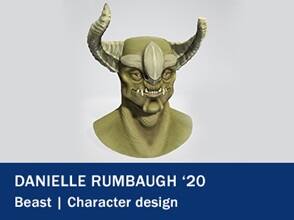Video Game Design Course Sexhdule
Register By: January 01 Classes Start: January 03
Level Up Your Skills
- $320/credit (120 total credits)
- Create a portfolio of front-end game art assets to show employers
- No application fee or SAT/ACT scores
- Transfer up to 90 credits
- Learn while using industry-standard 3D and 2D graphics software
- Get job-ready for game and simulation development
Game Art and Development Program Overview
Take your love of gaming and game design to a whole new level.
Whether it's imagining rich virtual game worlds or designing creatures from another planet, you'll be on the right path to the fast-paced, exciting world of video game art and design with SNHU's Bachelor of Arts in Game Art and Development.
As an online game design degree that zeroes in on game art, this program can help you build a portfolio of compelling front-end game designs. You'll use industry-standard 3D and 2D graphic software to learn and apply game design and game art principles such as:
- 3D modeling and sculpting
- Lighting, shading and texturing
- Illustration and digital painting
- Rigging and character animation
Creativity, critical thinking and technical skills all come together in this highly sought-after undergraduate program. The convenience of SNHU's online offering means you can remain located in the areas of the country where the markets are booming – the West Coast or Florida, for instance – and emerge with the skills you need to enter an industry that's both fast-paced and always changing.
Learn how to:
- Design professional-quality digital game and interactive media elements
- Recommend strategies that shape the design of digital games and interactive media
- Apply industry tools used to create digital games and other interactive media
- Evaluate and respond to problems through creative thinking and collaboration
- Optimize the design of interactive media elements within various digital platforms
Interested in the science behind gaming? Our online game programming degree program can teach you how to create interactive game experiences through rule design, play mechanics and more.
Career Outlook
According to Newzoo, the global video game industry is projected to grow to more than $218.7 billion by 2024.1 In addition, according to the U.S. Bureau of Labor Statistics, job growth for software developers and programmers is projected to grow 17% through 2029.2
SNHU offers a critical advantage in a highly competitive field, as our program uniquely focuses on today's industry standards and essential skill-building to excel in game art and design.
Whether it's for games or movies, ed-tech or the military, here are just a few careers you might land with an online game art degree:
- Environment artist. Create the virtual worlds and landscapes the game's characters will inhabit.
- 3D modeler. Build detailed 3D models of objects and characters.
- Animator. Animate objects, rigged characters and creatures.
- Concept artist. Envision and plan the look and feel of virtual worlds and characters.
- User interface (UI) artist. Design and draw the menus, heads-up display and other navigational components of a game or virtual environment.

The practical application of these skills is one of the big reasons Danielle Rumbaugh '20 was able to take her career to the next level.
"When I first started the game art program, I worked at a small game company," Rumbaugh said. "Applying the knowledge I learned from SNHU really pushed the limits of what I thought I was capable of."
Learning the ins and outs of industry tools, she made the decision to "jump right in and do it." That attitude ultimately helped her become her own boss.
"
Now, as a contract artist, Rumbaugh has already collected her share of big wins. She's even had her work featured in Aviation Week and Space Technology.
As far as future goals? She's aiming even higher. "I'm hoping that I will eventually be able to work on my first console game as a contract artist," she said.
Start Your Journey Toward an Online Game Art and Development Degree
Why SNHU for Your Online Game Art Degree
Admission Requirements
How to Apply
Courses & Curriculum
Our curriculum was designed to help you become proficient with design tools like Adobe Software Suite (Photoshop, Illustrator, InDesign) and 3DS Max. Armed with these tools, you'll build an eye-catching portfolio that includes original character and creature designs. You'll also gain demonstrated experience designing interactive 3D environments.
Courses mirror the standard workflow pipeline used in the industry for the production of art assets. You'll apply these skills to multiple video game platforms, including web, console, PC and mobile, so you'll be ready to hit the ground running in a fast-paced industry.
Additionally, our expert faculty of gaming vets can share their broad experience within the gaming industry.
Curriculum Requirements & Resources
- General education courses: All online bachelor's degree students are required to take general education classes, if not obtained in prior coursework. Through these foundation, exploration and integration courses, students learn to think critically, creatively and collaboratively, giving you the edge employers are looking for.
- Technology resources: We provide cloud-based virtual environments in some courses to give you access to the technology you need for your degree – and your career. Learn more about our virtual environments.
- Save time and tuition: Depending on your scores, you could earn up to 12 math credits – the equivalent of 4 courses – toward your degree for less than $50 per assessment with our two Pathways to Math Success assessments.
- Earn credits for what you already know: Did you know certain work and life experience – like industry-recognized certifications, law enforcement training and math knowledge – could save you time and money at SNHU? Learn how you could get credit for work or life experience.
Student Spotlight: John Lanier

For John Lanier '20, that meant building character designs for just about any type of game you can think of – from surrealist horror to go-cart style racing games.
"In my time at SNHU, I created player and non-player character concepts that evolved from quick thumbnail designs to these final versions," Lanier said. "Modeling was done in 3D Studio Max and Mudbox, with textures created in Photoshop – all programs introduced and taught within the program."
| Courses May Include | ||
|---|---|---|
| BA in Game Art and Development Online | ||
| GRA 201 | Intro to Digital Sculpting | In this course students will be introduced into Digital sculpting with zbrush. Also understand how digital sculpting fits into a pipeline in a game production environment. Techniques covered in this course will be software navigation, sculpting with multiple brushes, masking, poly painting, and materials. The course will cover some practices used to prep a model for the next stage in creating a game model. Some techniques will show how zbrush can work seamlessly with other 3D modeling software. The class will also have assignments that include observational and concept drawing. |
| GRA 202 | 3-D Modeling and Animation | In this course students will be introduced to 3DS max. It will give them an overview of what max does specifically for games. This course will be focused on modeling. Students will learn the basics of modeling low poly and high poly models. How they are unwrapped and used in conjunction with textures. It will also show a wide range of techniques used in the industry for modeling for mobile, PC and current generation consoles. |
| GRA 211 | Interactive Animation | This course focuses on programming capabilities to enhance graphic animations and user interfaces to provide spectacular interactive results. Those benefiting from this course include students in game development, advertising, marketing, education, web development, art and other fields that can benefit from interactive animated graphics helping to convey concepts. The course is intended for those with no programming experience as well as those with some programming background. The use and creation of animations will be covered at a level of interest to both those new as well as experienced. The results can be displayed by a browser from the internet or as standalone results displayable on a range of operating systems. This is a hands on computer based course in which the students create a number of individual projects based on their interests and capabilities, focusing on creativity and programming aspects of interactive animation. The course utilizes emerging technologies in interactive animation. |
| GRA 212 | 3-D Character Animation | This course will introduce students to character animation by learning the 12 principles of animation. We will also be going over the pipeline for skinning and rigging a character. |
| GRA 220 | Introduction to Digital Imaging | Using Photoshop and Illustrator software, this course is an introduction to professional computer graphics creation and to the software and hardware typically used in the graphic design, video, photography and interactive Web/multimedia industries. Emphasis will be placed on the professional use of image-capturing devices, such as scanners, digital still cameras and video cameras. Image editing and color management systems will be discussed and demonstrated. The important differences between vector and bitmap graphics will be defined, as will the significant differences in preparing images for print, broadcast and Web distribution. Students will be encouraged to experiment with their own and pre-existing images using sophisticated digital editing techniques such as layering, channel masking, filtering, cloning and montaging. Special attention will be paid to copyright awareness in the age of digital image. |
| GRA 311 | Environment Design | In the first half of this course students will be introduced to a pipeline for the creation of environments inside of a game studio. Students will be shown how to use reference drawings and images to help build props and environment pieces. Students will also be shown how these assets can be used, not only as standalone assets but to create other bigger picture assets when used as a modular set piece. Then the students will digitally sculpt environment assets from references provided to them. When the sculpting phase is finished the students will learn how to build a game model from their digital sculpt. Students will then create the textures that will be used for a final render. In the second half of this course students will be able to go through this same pipeline but instead of using provided artwork, they will create something from their own imagination. |
| GRA 401 | Character Design | This course will involve a combination of concept, texturing, digital sculpting and 3d modeling to create characters that would appear on both mobile and current generation consoles. Students will learn a proven pipeline used in the gaming industry to bring a concept to creation and ready for game implementation. The course will begin showing students how this pipeline works in combination of different types of software following a given concept. They will have the understanding of how specific software works along the path of the pipeline to create a character. Students will then be asked to create their own concept following the techniques used in class to present a finished game character for their final project. |
| GRA 402 | Creature Design | In this course students will be shown how creatures are created from an idea to a fully fleshed out game model. They will work through weekly assignments to see the connection of real world animals and fantasy creatures. Students will follow step by step instruction with supplied concepts to build a fantasy creature through real world animal anatomy and the creative process. In the second half of this course students will learn how to go through this same process of using reference of actual creatures/animals from the real world as a spring board to create their own fantasy creature. |
| GRA 440 | 3-D Art and Design | In this course students will explore how their individual creative strengths and digital skill sets fit into a professional work flow of commercial game production. Students will choose one or multiple aspects of game art creation: Character design, Environment design, or Animation. All creative work produced in this course will be executed in the context of strict deadlines that simulate industry expectation. Students will concentrate on game development source control and integration of art assets into a production pipeline. Each student develops a digital portfolio and website that showcase their ability to create professional creative art work. Students will learn the process of objective self-evaluation and peer criticism and preparing their portfolios to match professional job board postings. |
| GRA 492 | Game Art and Development Capstone | This capstone course is the culminating experience for the B.A. in Game Art and Development program. The aim of the capstone is to assess students' ability to synthesize and integrate the knowledge and skills they have developed throughout their coursework, rather than introducing new concepts. This course is structured to support student success in fulfilling program requirements. |
| Total Credits: 120 | ||
Minimum Hardware Requirements
Game Art & Development Required Hardware & Software
Tuition & Fees
As a private, nonprofit university, we're committed to making college more accessible by making it more affordable. That's why we offer some of the lowest online tuition rates in the nation—and haven't raised our costs in a decade.
We also offer financial aid packages to those who qualify, plus a 30% tuition discount for U.S. service members, both full and part time, and the spouses of those on active duty.
| Online Undergraduate Programs | Per Course | Per Credit Hour | Annual Cost for 30 credits |
|---|---|---|---|
| Degree/Certificates | $960 | $320 | $9,600 |
| Degree/Certificates (U.S. service members, both full and part time, and the spouses of those on active duty)* | $675 | $225 | $6,750 |
Tuition Rates are subject to change and are reviewed annually. *Note: students receiving this rate are not eligible for additional discounts.
Additional Costs No Application Fee, $150 Graduation Fee, Course Materials ($ varies by course)
Frequently Asked Questions
Do you need a degree to be a game artist?
What is a game art degree?
Can you get a game art degree online?
How much money do game artists make?
How hard is it to become a game artist?
What can I do with a game art degree?
What's the difference between game artists, animators, designers, producers and programmers?
Related Articles
References
Sources & Citations (1, 2, 3, 4)
Video Game Design Course Sexhdule
Source: https://www.snhu.edu/online-degrees/bachelors/ba-in-game-art-and-development
Posted by: moorehiment.blogspot.com

0 Response to "Video Game Design Course Sexhdule"
Post a Comment